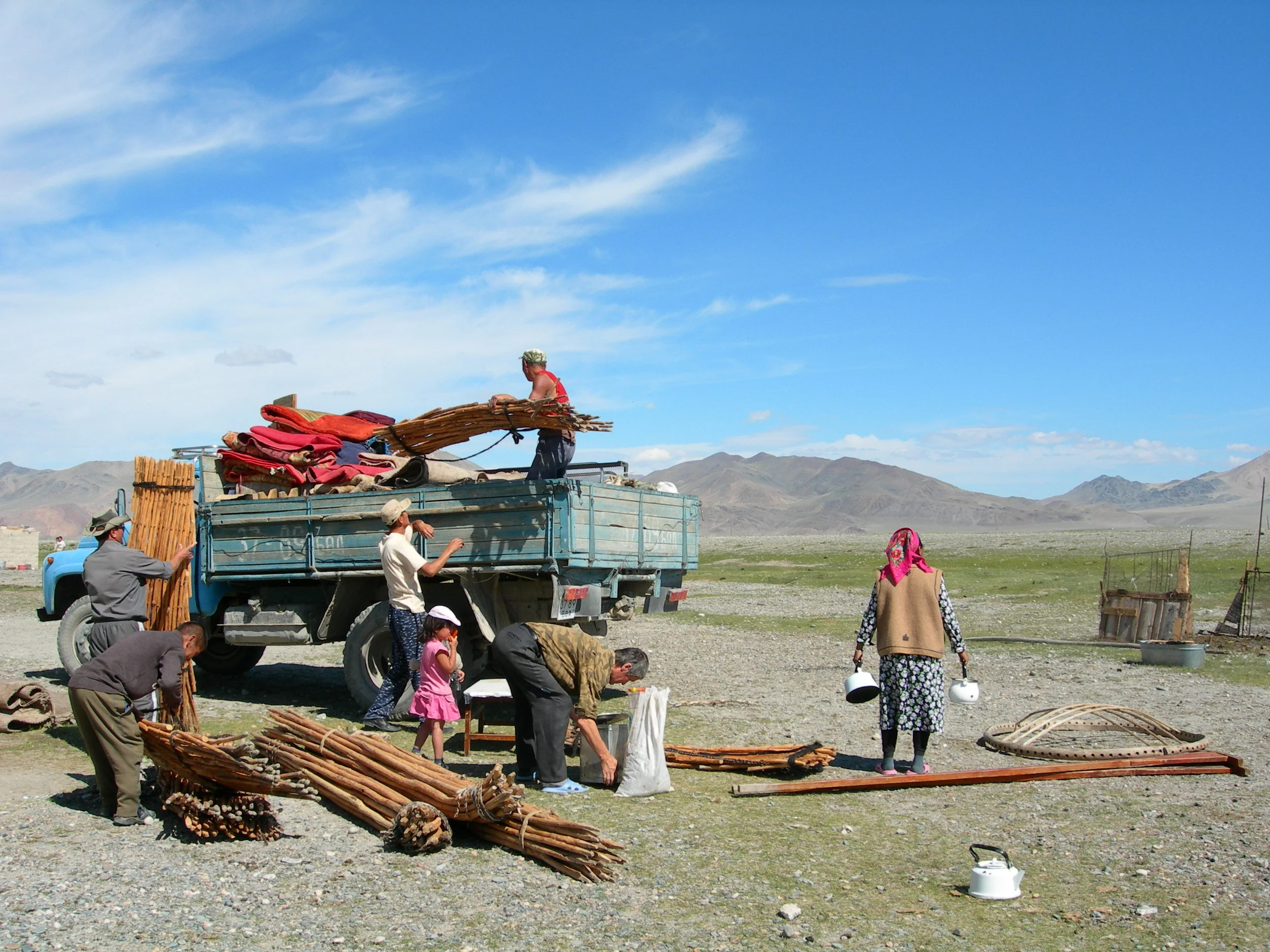4. DISASSEMBLY, REASSEMBLY
It takes anywhere from forty minutes to two hours to take apart a good sized ger or keegezoui. Depends quite a bit on the number of gates, the number of people at hand, the temperature outside and the mood of the group. In the end, moving is not so different from any other event in Mongolia. No one is ever in a hurry. The action is stretched out over the course of an afternoon and like all celebrations is accompanied by a good deal of tea, borsak (fried dough), butter. arak (fermented mares milk) and vodka. The first ger that I helped take apart was out past Ulaanhus Soum, a small settlement just south west of Bayan Olgii.
I heard that a family in a friend's hasha (family compound) was moving and that I should catch a shared jeep out immediately. Upon arrival, the family told me that they would move the following morning. The next day came and went, as did the following day and the following. I waited three days for the truck to come. Each day I was sure that if I left to go back to the amaig, the truck would show up and when I returned, I'd find nothing but an empty pasture. The logistics of trying to show up and live with a family just as they are about the move is vaguely ridiculous. It sounds sensible, but in actuality, no one knows when they will move. Of course, Mongolians and Kazakhs are so helpful that they won't hesitate to give you a clear date if you make it clear that you require notice, which in and of itself is a bizarre request to make. Living in the countryside makes a man patient. Moving in the countryside is inseparable from living in the countryside. Events pass with their own sense of timing. You wait for the truck. You wait for the frost. You wait for the horses to come back from the mountains.
Families begin packing early in the morning. Mongolian and Kazakh furniture is made for moving. Everything collapses on itself, comes apart and squeezes into other things. Gers are built around the furniture, not filled with furniture (on account of their tiny doors) and likewise are removed with the interior contents in place. This way, as the ger is unbound and unwrapped, with layers being peeled off baring a skeleton of wooden poles, there remains a clearly defined, comfortable space for drinking tea and welcoming guests. The house becomes a gazebo. Solid roofs become skylights. The feeling of marked space remains as the structure disintegrates.
Moving day unfolds in a series of controlled bursts of movement separated by long stretches of waiting for some unnamed guest or event. An understanding of the materiality, structure and spirit of these homes came into clearer focus with each ger that I watched come up or down.The prolonged building process, with its tea drinking and community gossip allowed plenty of time and space for inspecting, drawing and photographing the tiny details and connectors that make a ger a successful, efficient and captivating home: roof poles that have been steamed and bent into uniform curves then latched together with goat hair ropes, expandable gate walls jointed with thin leather hardened with fat, twenty foot long cones of inch-thick felt stretched over the frame to form a waterproof, insulated, breathable skin, the details of a painted door or ceiling cap with colored glass. All of the elements and interplay of materials, connection and fabrication are exposed as new pieces are revealed and separated.
A ger is not a complicated building form. Still, these homes possesses a grace and beauty which stems from a simplicity of geometry and an economy of materials. It is these materials which bear testament to the history of these homes. Stained and ripped patches of felt show the age of an insulation layer, the craftsmanship of its production, and the repairs that have been made over the years. I have been told that a family might use a ger frame for sixty years or more. But, in reality, it is difficult to place an age on a structure where all pieces can easily be replaced, patched, swapped or rebuilt with little noticeable change to the whole. Roof poles may be braced and swapped out, cap supports disappear and are replaced, felt is patched and reinforced and cotton top layers are frequently mended and replaced until it is impossible to tell just when the old ger became a new ger, when a full cycle has been completed and no original scrap remains.
Eventually, all the tea has been drunk, the layers of felt and canvas and cotton have been folded and bound, the poles and gates are tied up and ropes coiled. The truck is loaded with a sense of precision and satisfaction that reminds me of packing all of my belongings into the trunk of a small hatchback at the end of every school term in university. I've been told you can fit up to three gers, with furniture and family members in a truck. I have some doubts, but am sure its done.
Neighbors remount horses and motorbikes and ride to their own homes. The women squeeze into the cabin; the men clamber on top and hold onto the ropes and the dog runs behind if the ride is short. Nothing is left behind but a circle of yellow grass and a few tufts of goat hair.







